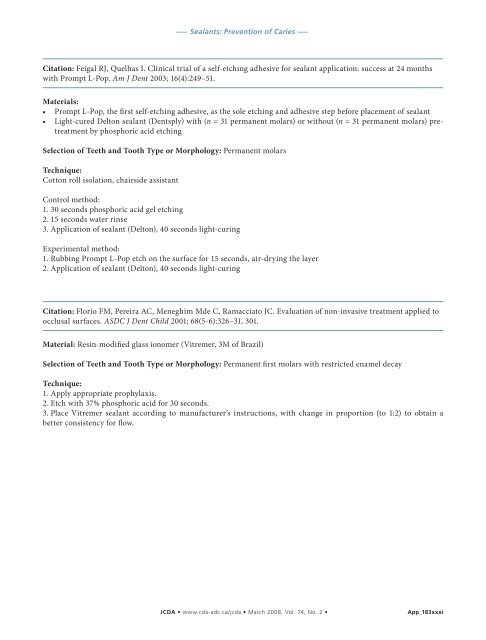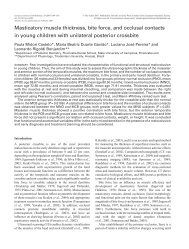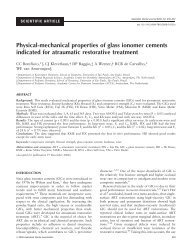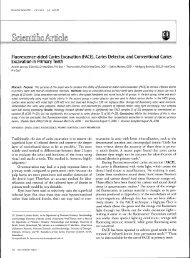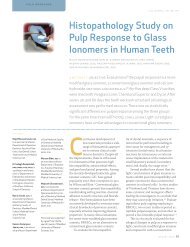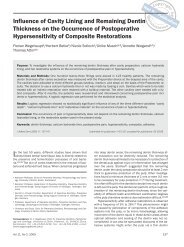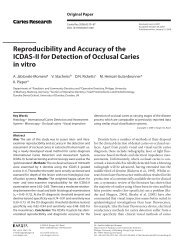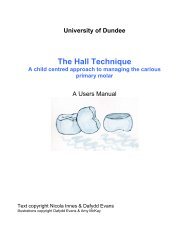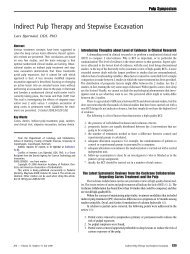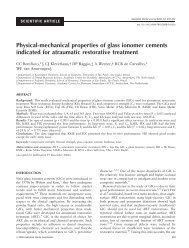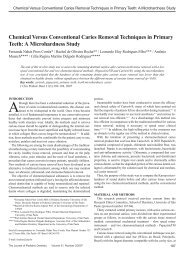Pit and Fissure Sealants in the Prevention of Dental Caries in ...
Pit and Fissure Sealants in the Prevention of Dental Caries in ...
Pit and Fissure Sealants in the Prevention of Dental Caries in ...
You also want an ePaper? Increase the reach of your titles
YUMPU automatically turns print PDFs into web optimized ePapers that Google loves.
––– <strong>Sealants</strong>: <strong>Prevention</strong> <strong>of</strong> <strong>Caries</strong> –––<br />
Citation: Feigal RJ, Quelhas I. Cl<strong>in</strong>ical trial <strong>of</strong> a self-etch<strong>in</strong>g adhesive for sealant application: success at 24 months<br />
with Prompt L-Pop. Am J Dent 2003; 16(4):249–51.<br />
Materials:<br />
• Prompt L-Pop, <strong>the</strong> first self-etch<strong>in</strong>g adhesive, as <strong>the</strong> sole etch<strong>in</strong>g <strong>and</strong> adhesive step before placement <strong>of</strong> sealant<br />
• Light-cured Delton sealant (Dentsply) with (n = 31 permanent molars) or without (n = 31 permanent molars) pretreatment<br />
by phosphoric acid etch<strong>in</strong>g<br />
Selection <strong>of</strong> Teeth <strong>and</strong> Tooth Type or Morphology: Permanent molars<br />
Technique:<br />
Cotton roll isolation, chairside assistant<br />
Control method:<br />
1. 30 seconds phosphoric acid gel etch<strong>in</strong>g<br />
2. 15 seconds water r<strong>in</strong>se<br />
3. Application <strong>of</strong> sealant (Delton), 40 seconds light-cur<strong>in</strong>g<br />
Experimental method:<br />
1. Rubb<strong>in</strong>g Prompt L-Pop etch on <strong>the</strong> surface for 15 seconds, air-dry<strong>in</strong>g <strong>the</strong> layer<br />
2. Application <strong>of</strong> sealant (Delton), 40 seconds light-cur<strong>in</strong>g<br />
Citation: Florio FM, Pereira AC, Meneghim Mde C, Ramacciato JC. Evaluation <strong>of</strong> non-<strong>in</strong>vasive treatment applied to<br />
occlusal surfaces. ASDC J Dent Child 2001; 68(5-6):326–31, 301.<br />
Material: Res<strong>in</strong>-modified glass ionomer (Vitremer, 3M <strong>of</strong> Brazil)<br />
Selection <strong>of</strong> Teeth <strong>and</strong> Tooth Type or Morphology: Permanent first molars with restricted enamel decay<br />
Technique:<br />
1. Apply appropriate prophylaxis.<br />
2. Etch with 37% phosphoric acid for 30 seconds.<br />
3. Place Vitremer sealant accord<strong>in</strong>g to manufacturer’s <strong>in</strong>structions, with change <strong>in</strong> proportion (to 1:2) to obta<strong>in</strong> a<br />
better consistency for flow.<br />
JCDA • www.cda-adc.ca/jcda • March 2008, Vol. 74, No. 2 • App_183xxxi


